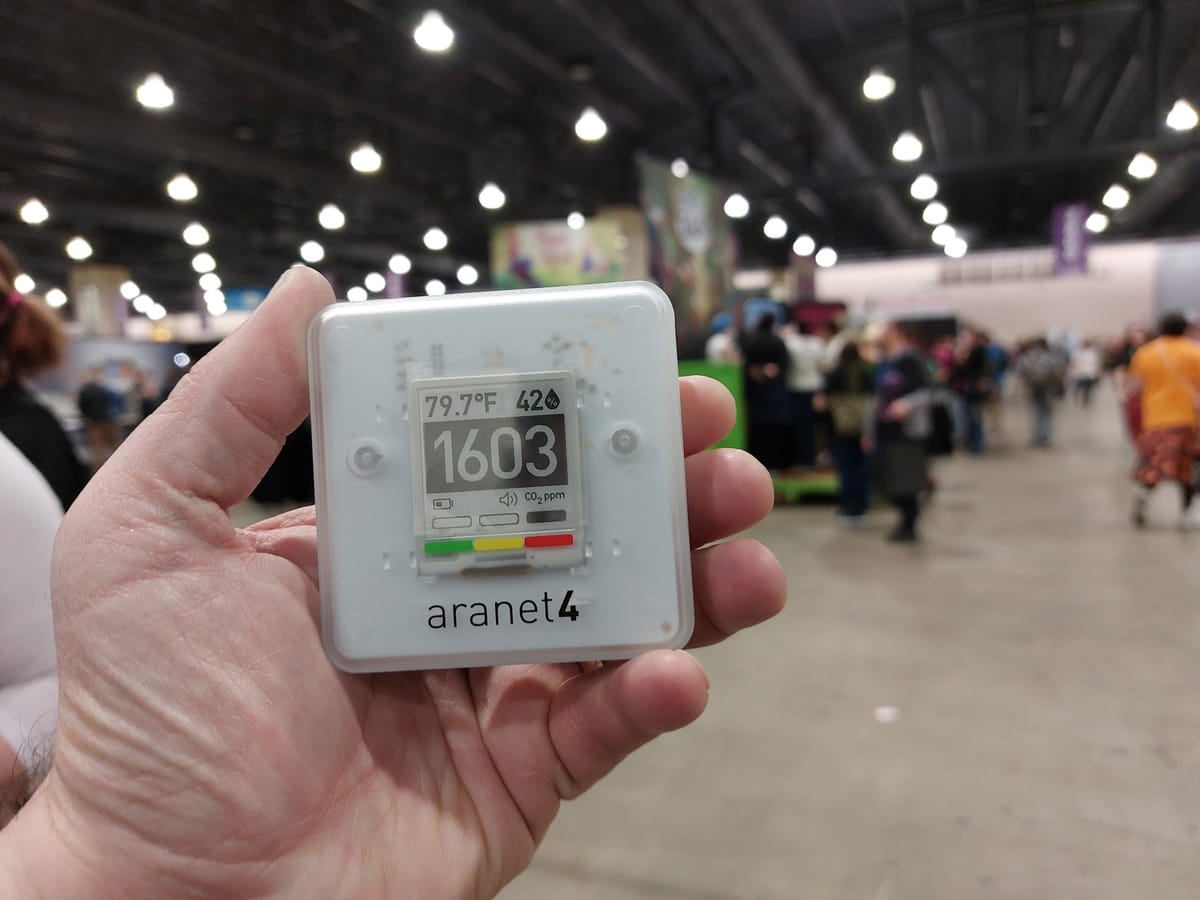Clearing the Air

Last week, organizers announced on social media that Big Bad Con (an annual game convention held in Burlingame, Calif., in the fall) and Big Bad Online (a TTRPG-related panel discussion series streamed on Twitch in the spring) would not be held in 2025. They left unanswered the question of whether the in-person event would return in 2026.
Big Bad Con is a mid-level convention that—like my own “backyard” con, Gamehole Con—has punched well above its weight in terms of the special guests it’s been able to attract. It’s probably best known for its commitment to championing diversity in roleplaying gaming, amplifying the voices of designers from marginalized communities and helping aspiring professionals from those communities connect with established figures in the industry. No reason was given for the cancellations, although reading between the lines—the announcement thanked “our volunteer staff and Rangers [for] exceed[ing] expectations in organizing last year’s convention,” which was marred by furious contention over the organizers’ attempts to avoid making condemnation of Israel’s war crimes in Gaza a centerpiece of the event—it’s easy to speculate that the organizers simply didn’t want to court the likelihood of an even more thanklessly contentious year, with said war crimes still going on and a faction of emboldened goons on a mission to extinguish the very values that BBC loudly and proudly stands for.
Because of BBC’s dedication to diversity, equity and inclusion, its absence from the convention calendar will be felt by many as a significant void. But I want to call attention to something else I found special about BBC: Its muscular public health policy. Even as recently as 2024, two years after President Biden and the Centers for Disease Control and Prevention called a premature end to the COVID-19 pandemic, BBC required attendees to be vaccinated and boosted against the disease, to test negative before arriving and to wear high-quality masks in all convention spaces. To the best of my knowledge, since 2022, no other game convention in North America has had an anti-COVID policy that came anywhere close to BBC’s. Most have given up on mitigation altogether.
This is a big problem.
In our notoriously precarious industry, self-employed writers, designers, artists and artisans can’t afford to get sick. We can’t afford to lose time to recovery, and we really can’t afford the risk of long-term disability. Even if we’re able to work while we’re sick, the quality of our work is going to be much lower—and every gig we apply for depends in large part on how we did on the last gig we got. So all of us in the TTRPG community owe it to one another, to ourselves, and to the creators of the games and game accessories we love to take care of one another.
When we’re looking at game conventions, this means paying attention to the quality of the air.
After two years of lockdown, 2022 was the first year since the start of the pandemic when organizers dared to resume holding game conventions, and they got off to a bad start: In April of that year, an Enforcer at PAX East died from a case of COVID-19 she contracted during the convention. (The convention required vaccines and masks, but the city of Boston, like many cities around the nation, had recently dropped all restrictions in public places, such as restaurants, bars and public transportation.)
That year, in support of MOAR! Monsters Know What They’re Doing and How to Defend Your Lair, I’d made plans to attend Gen Con, Gamehole Con and PAX Unplugged, but it seemed prudent to take some extra precautions. I invested in a supply of 3M Aura 9205+ N95 masks, which I wore at all times indoors; a Levoit PlasmaPro 600S room air purifier for my hotel rooms and spaces where I was running games; and an Aranet4 air quality monitor for evaluating the quality of convention center ventilation, using carbon dioxide level as a proxy.
A CO₂ level of 700 ppm or less can be considered reasonably safe for an unmasked individual. A level between 700 and 1,000 ppm is reasonably safe if you’re wearing a high-quality mask, or in a location where the HVAC system uses MERV-13 or HEPA filters. Unmasked individuals should avoid levels over 1,000 ppm: The risk of contracting COVID-19 from an infected individual in the space, if neither party is wearing a high-quality mask, is between 70 and 100 percent. Above 1,500 ppm, the buildup of stale, uncirculated air in indoor spaces means that even masking may not be enough protection if many infected individuals are present. (Aside from which, the CO₂ level itself leads to observable declines in cognitive ability at levels of 950 ppm and up. Who wants to play thinkin’ games in an environment like that?)
So imagine how I felt as I stood in the will call line in the Indiana Convention Center, waiting to pick up my Gen Con two-day badge, watching the CO₂ number on my monitor rise from 1,800 ppm to over 2,200 ppm.
On paper, and to some extent in practice, Gen Con took a respectably hard line on COVID-19 safety that year: It required proof of vaccination from all attendees as well as masking in all convention spaces (although it didn’t specify what kind or quality of mask, and ineffective cloth masks were in widespread use). Enforcement was polite but firm, but I noticed that in corners of the convention far from staff desks, masks tended to come off. And in nearly every panel discussion and game room, the CO₂ levels were bonkers, to the extent that the 1,300 to 1,400 ppm I measured in the vendor hall was a welcome reprieve, and the 900 to 1,000 ppm of the Indianapolis Marriott mezzanine across the street felt like an outright blessing. In a room with a CO₂ level above 1,800 ppm, I watched every single member of a discussion panel remove their mask as the talk began. (Over the next five days, I also watched every single member of that panel announce their COVID-positive status on Twitter.) I’d intended to stay all day Thursday and Friday and drive home Saturday morning, but by midday Friday, I was having a panic attack—not something I’ve been prone to in my life—and bounced early.
In 2023, under pressure from attendees and the Indiana General Assembly, Gen Con dropped all its COVID mitigations. I haven’t been back, and at this point I don’t think I’ll ever go back.
In contrast, the Alliant Energy Center Exposition Hall in Madison, Wis., home of Gamehole Con, was a breath of fresh air. In 2022, over four days, nearly all the readings I took in public spaces of that convention center were between 500 and 800 ppm. The highest reading I took, 1,200 ppm, was in one of the interior game rooms. As attendance has increased in 2023 and 2024, these numbers have crept up, but not by a lot: The vast majority of levels this past year were between 700 and 900 ppm.
PAX Unplugged also took COVID very seriously in 2022. The Enforcers enforced, and high-quality masks were in evidence everywhere (the exception being the coat check staff, who’ve consistently shown unabashed contempt for any sort of anti-COVID measure). The peak of traffic on Saturday afternoon saw the CO₂ level in the vendor hall push above 1,600 ppm, but aside from those few hours, most of the readings I took were between 800 and 1,200 ppm—numbers I could live with, as long as I kept my mask on. I wish I could say the same about PAX Unplugged the following year, though. I don’t know whether attendance was higher, there was something wrong with the ventilation system or both, but CO₂ levels in the hallways were consistently around 900 to 1,000 ppm, while game rooms were up around 1,600 ppm and auditoriums between 1,400 and 1,800 ppm. The most shocking and depressing reading I took was in the AFK Quiet Room, intended as “a low-sensory quiet space at PAX where attendees can rest, recharge, and reclaim their calm”: over 1,900 ppm. At the same time, PAX was “recommending” masks but not requiring them; maybe 30 percent of attendees, at most, wore them of their own volition.
“Why does all this matter? The pandemic is over, right?” Only in the narrow definitional sense that COVID isn’t surging everywhere all at once. It is still everywhere in varying degrees, though, with levels occasionally rivaling the delta variant peak of 2021; it’s just that most of the useful data are gone, because people aren’t reporting their cases anymore. We do still have one remaining measure we can work with to assess risk—wastewater viral load—and by some minor miracle, the CDC is still gathering and reporting the data. You can see it here.
Even though it’s largely out of the news, people are still dying of COVID—mostly, though not exclusively, patients who were never vaccinated or who stopped getting boosters that protect against new variants. Long COVID is still a major risk, a condition that wrecks lives even among the young and apparently healthy, and as I mentioned, the TTRPG industry is already notoriously economically precarious. Plus, the constant presence of COVID combined with the absence of mitigations means players and creators with compromised immune systems—who are more likely to catch COVID, likely to get sicker from it and more likely to die from it—are shut out of one of the most important social functions of our hobby.
Which brings me back to Big Bad Con. It didn’t just cater to marginalized members of the TTRPG community, although the fact that it did that remains important. It also set a standard that declared, “We can protect the health of all our attendees, and we should do that, and we will.”
I took my Aranet4 with me when I attended BBC in 2023, too, and in the atrium of the Hyatt Regency San Francisco Airport, where BBC was held, I never took a single CO₂ reading above 600 ppm. Being in that atrium was nearly as good as being outside. The readings I took in the panel rooms were mostly between 800 and 1,000 ppm. The highest reading I took, in a guest room in which I played a game of Blades in the Dark, was around 1,100 ppm.
And everybody, without exception, was wearing a high-quality mask, except when they were eating.
Other game conventions haven’t followed the example BBC set, unfortunately, so I don’t know that convention attendance is about to become significantly more dangerous in its absence. Rather, I think it’s already become significantly more dangerous—especially for vendors, who are a captive population at cons, stuck in the exhibit halls that are those cons’ most heavily trafficked places—and we need to talk about that. Even if no one else followed BBC’s example, that example was useful to have: It was an annual reminder that, yes, the health of our community matters, and it’s not something we’re powerless to do anything about.
At this point, public opinion—even among COVID non-deniers—has shifted strongly against mask requirements, and there’s no putting that toothpaste back in the tube. But there is one measure that I believe convention organizers can and should adopt to safeguard the health of attendees, which will help protect not just against COVID-19 but also against flu, RSV and the perennial “con crud” that was already notorious even before the pandemic occurred: Organizers should demand of venues, and attendees should demand of organizers, that the venues’ ventilation systems must be capable of replacing indoor air with outdoor air at a rate sufficient to keep CO₂ levels under 1,000 ppm at all times, in all locations in the convention space, with the highest projected number of attendees on site. That means if a con expects as many as 20,000 attendees, with a peak of 12,000 on site at one time (for the record, I just pulled these numbers out of my bag of holding), that’s how many people’s exhalations the venue’s ventilation system has to pump out of the roof fans. Under 800 ppm would be better but may not be achievable. Under 1,000 ppm is achievable, has been achieved, and is the bare minimum we should accept.
I think Gen Con in particular is failing its attendees on many levels (we could also, for instance, talk about the hotel room situation), but the quality of the ventilation at ICCLOS is not only egregious but, in my opinion, almost entirely overlooked. It’s not enough for the venue to be able to fit 70,000 attendees. It also has to be able to provide 70,000 attendees with air worth breathing. ICCLOS is manifestly incapable of that. With CO₂ levels above 2,200 ppm in areas that every attendee has to spend at least half an hour passing through, if anyone in that space is sick, a whole bunch more people are getting sick, too.
But I’ve always felt like Gen Con was dragged kicking and screaming into doing the right thing in 2022 and was happy to revert to doing the easiest thing as soon as it had the chance. It’s PAX Unplugged that frustrates me more, because it got things so right in 2022 and then turned around and got them so wrong in 2023. I don’t know how things were last year, because I didn’t attend—but I’m considering attending this year, and before I do, I want to know whether any improvements have been made or will be made. 1900 ppm CO₂ in the AFK Room … man, talk about failing your most vulnerable attendees. That’s supposed to be the safe place, a refuge from the stresses of the rest of the con. It shouldn’t be a stressor in and of itself.
The next time you’re looking at attending a convention, ask the organizer to look into the quality of ventilation at the con venue. Ask them to find out how the venue’s system handles the largest crowd they anticipate receiving. Ask them to inquire into whether any improvements are forthcoming. Ask them whether the system uses MERV-13 or HEPA-rated filters. Let them know it matters to you, not just for your own health but for the health of our whole community.
And thank you, Big Bad Con, for the leadership you’ve shown in this area, and for showing attendees that our lives and health matter to you more than our registration fees.
To read more about using CO₂ levels as a proxy for ventilation quality and COVID-19 risk, visit https://airsupportproject.com/poor-ventilation-understanding-co2/.
Correction: Originally, I wrote that it was unclear whether Big Bad Online would return in 2026. The organizers have stated that it will.

In The Monsters Know What They’re Doing, the essential tactics guide for Dungeon Masters, and its sequel, MOAR! Monsters Know What They’re Doing, I reverse-engineered hundreds of fifth edition D&D monsters to help DMs prepare battle plans for combat encounters before their game sessions. Now, in Making Enemies: Monster Design Inspiration for Tabletop Roleplaying Games, I explore everything that goes into creating monsters from the ground up: size, number, and level of challenge; monster habitats; monster motivations; monsters as metaphors; monsters and magic; the monstrous anatomy possessed by real-world organisms; and how to customize monsters for your own tabletop roleplaying game adventuring party to confront. No longer limited to one game system, Making Enemies shows you how to build out your creations not just for D&D 5E but also for Pathfinder 2E, Shadowdark, the Cypher System, and Call of Cthulhu 7E. Including interviews with some of the most brilliant names in RPG and creature design, Making Enemies will give you the tools to surprise and delight your players—and terrify their characters—again and again.
Preorder today from your favorite independent bookseller, or click one of these links:
Spy & Owl Bookshop (hi it me) | Barnes & Noble | Indigo | Kobo | Apple Books

